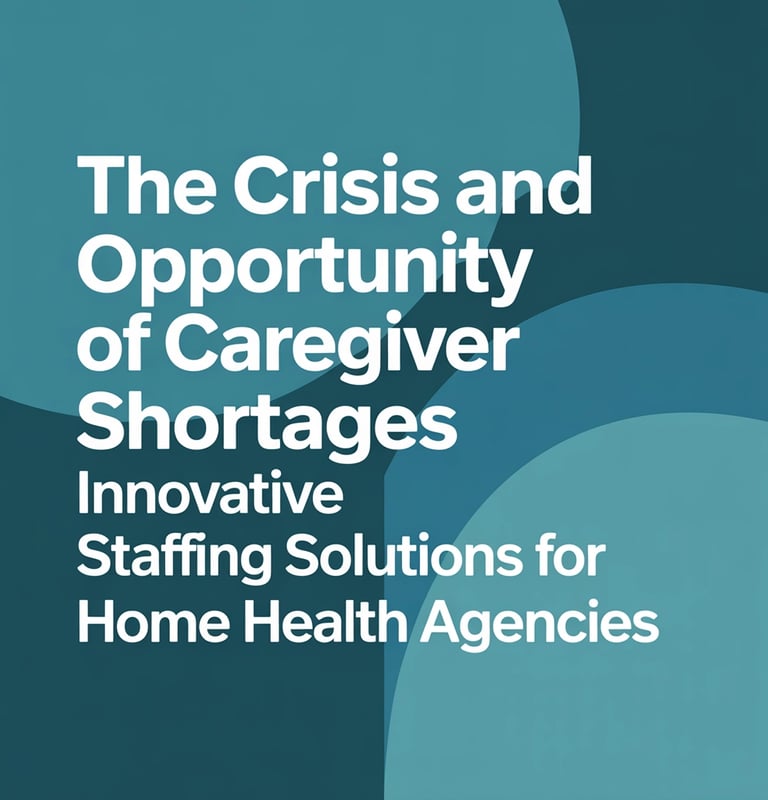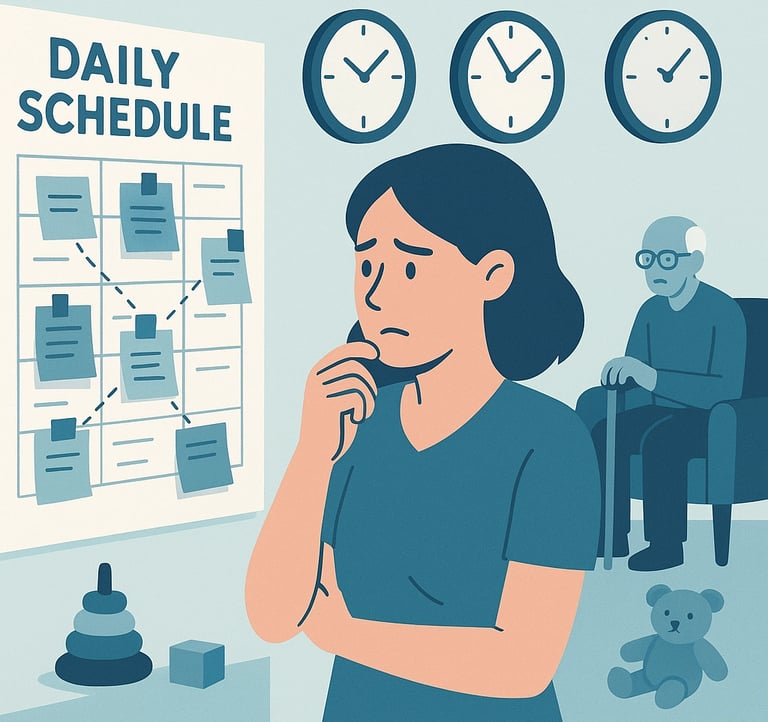The Crisis and Opportunity of Caregiver Shortages: Innovative Staffing Solutions for Home Health Agencies
Caregiver shortages are shaking up the home health industry, but agencies can turn this crisis into an opportunity. This piece explores practical, innovative staffing solutions like tech-savvy recruitment, flexible scheduling, and building community partnerships. Discover actionable strategies to strengthen your team, improve retention, and deliver reliable care...even in tough times.
8/21/20256 min read


The Caregiver Shortage: Scale and Impact
In 2025, America is experiencing an unprecedented shortage of caregivers. Today, roughly 63 million Americans are providing unpaid care to an adult or child, which is nearly one in four adults. Over the last decade, that number has climbed by 45%, reshaping how families, communities, and healthcare providers approach support for older adults, people with disabilities, and chronically ill loved ones.
This shortage doesn't only affect families in need. It challenges home health agencies to deliver high-quality care when competition for skilled, committed caregivers has never been tougher. An estimated 20 million people with disabilities are directly affected, and agencies across the country are grappling with high turnover, staffing gaps, and curtailed services due to a workforce in crisis.
Family caregivers are also feeling the pressure. Increased demand, combined with a lack of professional availability, means more Americans are navigating care alone or with insufficient support. For home health agencies, the pressure is on to find creative solutions, streamline operations, and better support both staff and clients.


What’s Fueling the Caregiver Shortage?
Multiple factors have contributed to this crisis. Economic pressures remain front and center. Caregivers—both professional and unpaid—often receive wages and benefits that don't reflect the gravity or complexity of their work. According to recent reports, family caregivers spend an average of $7,200 per year of their own money on care, often sacrificing financial security and their own health.
Turnover in the paid caregiving workforce is fueled by:
Low wages and limited access to benefits
Unpredictable schedules that make personal planning difficult
Limited opportunities for career growth or advancement
The emotional and physical toll of caregiving roles
Demographic changes also play a role. The average caregiver isn’t who they used to be. Younger generations—millennials and Gen Z—are stepping into caregiving roles while juggling work and raising children themselves. This "sandwich generation" is stretched thin, increasing the strain on all sides.
COVID-19 intensified these challenges. At the height of the pandemic, 68% of direct service providers closed at least one service, primarily due to workforce shortages. In many states, those shortages led to permanent closures of agencies and a sharp drop in available care options.
The Hidden Opportunity for Home Health Agencies
While the challenges are significant, they come paired with opportunity. The pressure of the caregiver shortage is pushing agencies to evolve—accelerating the shift to smarter, more resilient staffing models and fostering innovation in service delivery.
The growing recognition of caregivers as the backbone of healthcare has spurred momentum for policy change, from proposed federal tax credits supporting caregivers to increases in funding for support programs. Agencies that can adapt quickly and advocate for policy support may open new avenues for both stability and growth.
The current landscape rewards those willing to think creatively, strategically, and collaboratively. Agencies that can innovate not only survive, but can thrive, differentiating themselves in a crowded and competitive market.
Innovative Staffing Solutions That Work
Home health agencies leading the way are deploying creative strategies to overcome staffing shortages and build a sustainable care model. Here’s what stands out:
1. Leveraging Technology for Smarter Staffing
Digital tools are transforming scheduling, communications, and everyday operations. AI-driven platforms analyze caregiver availability and client needs, then auto-match schedules to maximize coverage and reduce gaps. This cuts down on idle time and boosts satisfaction for both staff and clients.
Apps and online portals enable caregivers to swap shifts, update availability, and get instant notifications. That real-time access makes it easier to cover last-minute call-outs or fill open slots—minimizing disruptions for families.
2. Flexible Supplemental Staffing Pools
Some agencies are turning to flexible staffing pools or partnerships with specialized healthcare staffing firms. With the ability to onboard qualified professionals at short notice, agencies reduce risks tied to seasonal surges, holidays, or unexpected staff absences.
These pools can support everything from quick fills to long-term coverage needs, giving agencies room to balance quality with adaptability—a must in today’s turbulent labor market.


3. Building Collaborative Care Networks
Strength in numbers. By joining or initiating collaborative care networks with other agencies, healthcare facilities, and community partners, agencies can share resources and maintain service continuity. When one agency hits a staffing shortfall, others in the network can step in to bridge the gap—ensuring clients never experience lapses in their care.
These networks encourage best practice sharing too. Agencies can swap ideas, refer talent, and even develop joint training or wellness programs for staff.
4. Prioritizing Retention Through Training & Career Growth
Agencies retaining staff in this market understand that investment in people pays off. Enhanced onboarding, ongoing training, and well-defined career pathways not only improve skill levels, but also build loyalty.
Offering leadership tracks, skill certifications, and opportunities to step into new roles motivates caregivers to stay longer. Agencies also see benefits when they create mentorship programs pairing experienced staff with newcomers—a method proven to boost engagement and reduce turnover.
5. Improving Compensation and Scheduling Predictability
Competitive wages and reliable schedules matter more than ever. When agencies pay attention to market rates, offer meaningful benefits, and provide predictable hours, they see higher retention. Flexible scheduling and reduced reliance on mandatory overtime help staff maintain balance, which in turn leads to better care for clients.
Some agencies are even experimenting with “alternative compensation” options—like tuition reimbursement, childcare assistance, or mental health support—to entice caregivers, especially among younger workers.
6. Tapping Into Community and Policy Resources
Successful agencies look outward, not just inward. By working with local colleges, workforce boards, and advocacy organizations, agencies can find new recruitment channels and access grants that fund both training and wage increases.
There’s also a trend toward active participation in advocacy efforts. Agencies voicing support for caregiver tax credits, expanded Medicaid support, or caregiver wellness grants are helping to drive long-term policy changes that benefit the sector as a whole.
Strategies for Implementation: Bringing Ideas to Life
Start small and scale quickly. Most agencies find that pilot projects—like testing a new scheduling tech platform with a limited team—yield valuable lessons before a full rollout.
Success also depends on clear communication. Engaging staff at every level, from new hires to veterans, ensures buy-in and generates critical feedback. Agencies that gather staff input before making changes usually avoid missteps, and they build a culture of inclusion and respect.
Finally, agencies need systems for ongoing evaluation. Monitoring turnover rates, client satisfaction, and efficiency metrics helps agencies adapt and fine-tune as their teams and client needs evolve.


The Road Ahead: Preparing for Long-Term Change
The caregiver shortage has changed the future of home health care—for good. The organizations best positioned to not just weather the storm, but thrive through it, are those willing to innovate, collaborate, and lead with purpose.
Advances in scheduling technology, flexible staffing models, training investments, and collaborative networks all offer hope for a more stable and attractive caregiving profession. At the same time, agencies prepared to embrace change, cultivate talent, and advocate for real policy reform will find themselves ahead of the curve as America’s demand for care continues to climb.
To stay updated on evolving industry challenges and solutions, visit Care Network News or connect with our team for tailored strategies at Senate Healthcare LLC.
References:
JM Search: The Top 4 Trends Affecting the Home Health Care Industry in 2025
https://jmsearch.com/blog/the-top-4-trends-affecting-the-home-health-care-industry-in-2025/McKnight’s Home Care: 9 Workforce Trends to Focus On in 2025
https://www.mcknightshomecare.com/9-workforce-trends-to-focus-on-in-2025/Learn2Care: How Generative AI is Revolutionizing Home Care & Caregiver Training
https://www.learn2care.us/blog/generative-ai-in-home-care-improving-home-care-experience-and-support/Caring Franchise: 11 Effective Recruitment Strategies for Hiring Caregivers
https://caringfranchise.com/blog/caregiver-recruitment-strategies/Vitable Health: 2025 Home Care Staffing & Retention Strategy Guide
https://www.vitablehealth.com/blog/home-care-staffing-hiring-retention-headaches-2025Home Health Care News: Top Home Care Trends For 2025
https://homehealthcarenews.com/2025/01/top-home-care-trends-for-2025/LinkedIn: The Healthcare Staffing Landscape in the U.S. in 2025
https://www.linkedin.com/pulse/healthcare-staffing-landscape-us-2025-a2zxperts-3b9acNurseMagic: How to Use AI to Improve Staff Productivity in Home Health Care
https://www.nursemagic.ai/post/how-to-use-ai-to-improve-staff-productivity-in-home-health-care
Unlock Your 30-Minute Agency Succession Review
Maybe you're ready to expand your reach, or perhaps it's time to consider your legacy and the future of your business. Either way, it all begins with a conversation. Schedule a confidential, no-obligation call to explore what the future might hold for you and your business.
Complete the form, and we'll reach out for a chat...


© 2025 SENATE HEALTHCARE LLC.
ALL RIGHTS RESERVED


